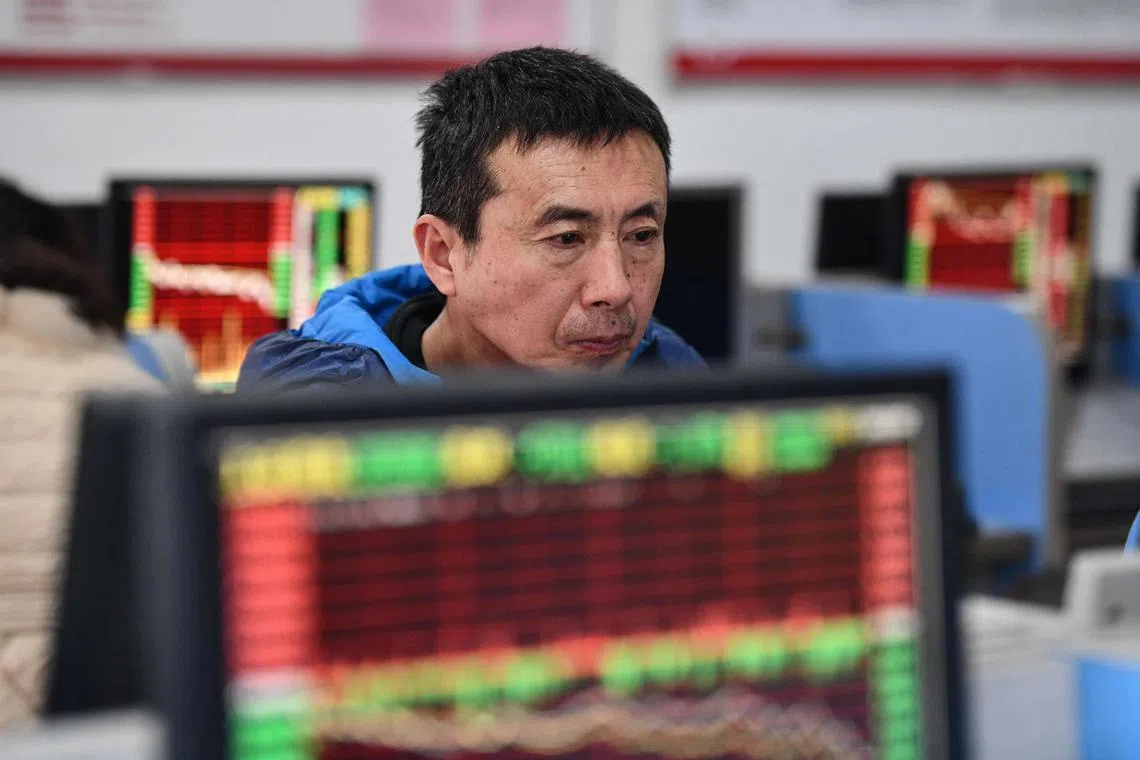China stocks rebound as Beijing intensifies efforts to stem rout
Sign up now: Get ST's newsletters delivered to your inbox

The latest move comes as China struggles to end a three-year rout that has erased some US$7 trillion (S$9.4 trillion) of value.
PHOTO: AFP
Follow topic:
SHANGHAI - Chinese equities rallied on Feb 6 as Beijing stepped up its efforts to stem a rout with a string of policy announcements, including a state fund’s vow to boost stock purchases.
The onshore benchmark CSI 300 Index climbed as much as 2.8 per cent, offering a reprieve to investors who have had to grapple with wild market swings over the past two sessions. The Hang Seng China Enterprises Index of major Chinese companies listed in Hong Kong jumped more than 4 per cent.
Hopes are also building for more concerted efforts to boost shares as regulators plan to brief President Xi Jinping on the markets as soon as Feb 6.
The latest move comes as policymakers struggle to end a three-year rout in the stock market that has erased some US$7 trillion (S$9.4 trillion) of value and dented confidence in the world’s second-largest economy.
Stocks started the day higher as Central Huijin Investment, the unit that holds Chinese government stakes in big financial institutions, said it will continue to increase holdings of exchange-traded funds. That was soon followed by the securities regulator pledging to make greater efforts in guiding long-term funds to enter the market.
Long Hui Fund Management investment director Zhou Nan said: “Huijin’s announcement will guide and encourage more funds to buy, and also confirms the market speculation on more state buying recently. There’s very limited room for further slide, but the market may continue to fluctuate before the bottom can be solidified.”
The national team – state-related bodies that the Chinese authorities lean on to buy stocks during times of turbulence – has bought roughly 70 billion yuan (S$13.2 billion) of onshore Chinese shares in the past month, according to estimates by Goldman Sachs, which did not say how it arrived at the numbers.
The upswing comes after the benchmark CSI 300 plunged to a five-year low on Feb 2. Traders were grappling to find a bottom for this rout as economic and geopolitical risks kept piling up, while the authorities have so far failed to confirm a much-anticipated stock rescue fund.
Policymakers have been more vocal in expressing market support lately, but concrete measures have been lacking. The securities watchdog vowed this week to punish those behind “malicious” short selling and to stop illegal behaviour that hinders stable stock market operations. The authorities are also seeking to address risks stemming from margin calls and share pledges.
A more proactive stance from regulators is drawing comparisons with the steps taken during the 2015 rout, when they curbed speculative trading, targeted market manipulation and guided some investors to avoid stock sales. Yet, equities back then took months to eventually bottom out and peaked at a much lower level than the 2015 high – foreboding a tough battle ahead for Beijing this time around.
Buying by state-backed funds had been keenly watched by investors as the sell-off deepened in 2024. The total amount of inflows into a handful of exchange traded funds (ETFs) tracking key gauges rose to a record in January and was more than five times the aggregate amount seen in July 2015, when the so-called national team jumped in to stem a rout.
This is the first time since October that Central Huijin, a unit of the US$1.4 trillion wealth fund China Investment Corporation, said it is buying more ETFs. The most-purchased ETFs year to date include large-cap focused ones such as the Huatai-Pinebridge CSI 300 ETF and E Fund CSI 300, as well as the E Fund ChiNext Price Index ETF and the ChinaAMC CSI Science and Technology Innovation Board 50 ETF.
China is also tightening trading restrictions on domestic institutional investors and some offshore units, Bloomberg News reported, as policymakers look to arrest the market swoon that has seen the CSI 300 Index tumble more than 40 per cent from a February 2021 peak.
Officials this week have also imposed caps on some brokerages’ cross-border total return swops with clients, limiting a channel that can be used by China-based investors to short Hong Kong stocks. BLOOMBERG

